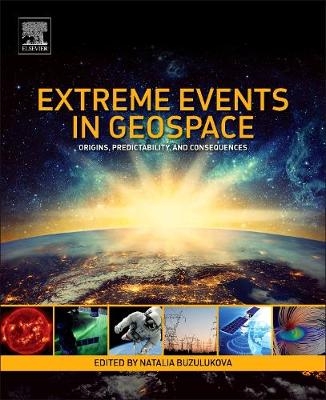
Extreme Events in Geospace
Elsevier Science Publishing Co Inc (Verlag)
978-0-12-812700-1 (ISBN)
Given that extremes in ionizing radiation, ionospheric irregularities, and geomagnetically induced currents may have the potential to disrupt our technologies or pose danger to human health, it is increasingly important to synthesize the information available on not only those consequences but also the origins and predictability of such events. Extreme Events in Geospace: Origins, Predictability, and Consequences is a valuable source for providing the latest research for geophysicists and space weather scientists, as well as industries impacted by space weather events, including GNSS satellites and radio communication, power grids, aviation, and human spaceflight.
The list of first/second authors includes M. Hapgood, N. Gopalswamy, K.D. Leka, G. Barnes, Yu. Yermolaev, P. Riley, S. Sharma, G. Lakhina, B. Tsurutani, C. Ngwira, A. Pulkkinen, J. Love, P. Bedrosian, N. Buzulukova, M. Sitnov, W. Denig, M. Panasyuk, R. Hajra, D. Ferguson, S. Lai, L. Narici, K. Tobiska, G. Gapirov, A. Mannucci, T. Fuller-Rowell, X. Yue, G. Crowley, R. Redmon, V. Airapetian, D. Boteler, M. MacAlester, S. Worman, D. Neudegg, and M. Ishii.
Dr. Natalia Buzulukova is a research scientist in University of Maryland/NASA GSFC, Heliophysics Science Division, Maryland, US. She obtained her PhD from Moscow Space Research Institute working in the field of plasma physics and data analysis. Dr. Buzulukova’s scientific interests cover a broad range of topics, including magnetohydrodynamic modeling of the Earth’s magnetosphere, kinetic Particle-In-Cell simulations of the geomagnetic tail, bounce-averaged models of the Earth’s ring current, modeling of the Earth’s plasmasphere, modeling of energetic neutral atom emissions, modeling of the Earth’s radiation belts, and space weather applications. Dr. Buzulukova is experienced in working with satellite data sets, including past and current NASA missions, and has authored or co-authored more than 20 publications in peer-reviewed journals related to the field.
Part 1: Overview of Impacts and Effects 1. Linking Space Weather Science to Impacts--The View from Earth
Part 2: Solar Origins and Statistics of Extremes 2. Extreme Solar Eruptions and their Space Weather Consequences 3. Solar Flare Forecasting: Present Methods and Challenges 4. Geoeffectiveness of Solar and Interplanetary Structures and Generation of Strong Geomagnetic Storms 5. Statistics of Extreme Space Weather Events 6. Data-Driven Modeling of Extreme Space Weather Events and their Predictability
Part 3: Geomagnetic Storms and Geomagnetically Induced Currents 7. Super Geomagnetic Storms: Past, Present, and Future 8. An Overview of Science Challenges Pertaining to our Understanding of Extreme Geomagnetically Induced Currents 9. Extreme-Event Geoelectric Hazard Maps 10. Global 3D Modeling of the Earth's Magnetosphere for Extreme Geomagnetic Storms 11. Empirical Modeling of Extreme Events: Storm-time Geomagnetic Field, Electric Current, and Pressure Distributions
Part 4: Plasma and Radiation Environment 12. Observations of Extreme Events from GOES Spacecraft 13. Near-Earth Radiation Environment for Extreme Solar and Geomagnetic Conditions 14. Magnetospheric "Killer" Relativistic Electron Dropouts (REDs) and Repopulation: A Cyclical Process 15. Extreme Space Weather Spacecraft Surface Charging and Arcing Effects 16. Deep Dielectric Charging and Spacecraft Anomalies 17. Solar Particle Events and Human Deep Space Exploration: Measurements and Considerations 18. Extreme Events in Atmospheric Radiation at Aviation and Suborbital Altitudes 19. High Energy Transient Luminous Atmospheric Phenomena: The Potential Danger for Suborbital Flights?
Part 5: Ionospheric/Thermospheric Effects and Impacts 20. Ionosphere and Thermosphere Responses to Extreme Geomagnetic Storms 21. How the Thermosphere and Ionosphere Might React to an Extreme Space Weather Event 22. The Effect of Solar Radio Bursts on GNSS Signals 23. Extreme Ionospheric Storms and Their Effects on GPS Systems 24. Recent Geoeffective Space Weather Events and Technological System Impacts 25. Extreme Space Weather in Time: Effects on Earth and Mars
Part 6: Dealing with the Space Weather 26. Dealing with Extreme Space Weather: The Canadian Experience 27. Space Weather: What are Policy Makers Seeking? 28. Extreme Space Weather and Emergency Management 29. The Social and Economic Impacts of Severe Space Weather 30. Extreme Space Weather Events in the Australian Contex 31. Extreme Space Weather Research in Japan
| Erscheinungsdatum | 13.12.2017 |
|---|---|
| Sprache | englisch |
| Maße | 191 x 235 mm |
| Gewicht | 1610 g |
| Themenwelt | Naturwissenschaften ► Geowissenschaften ► Geophysik |
| Naturwissenschaften ► Physik / Astronomie ► Angewandte Physik | |
| Naturwissenschaften ► Physik / Astronomie ► Astronomie / Astrophysik | |
| Technik ► Fahrzeugbau / Schiffbau | |
| Technik ► Luft- / Raumfahrttechnik | |
| ISBN-10 | 0-12-812700-7 / 0128127007 |
| ISBN-13 | 978-0-12-812700-1 / 9780128127001 |
| Zustand | Neuware |
| Haben Sie eine Frage zum Produkt? |
aus dem Bereich


